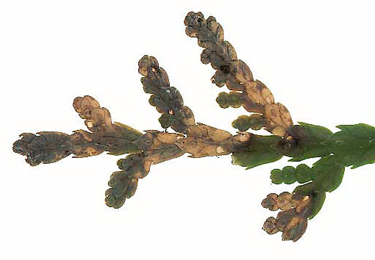|
||||||
|
CUPRESSOCYPARIS. [Cupressaceae] |
|
Cupressocyparis leylandii is treated as X Cuprocyparis leylandii by Stace (2010). See CUPROCYPARIS. |
|
Key for the identification of the known mines of British |
1a > Leaf-miner: Oviposition on a young shoot. The larva penetrates a leaf, empties it, leaves it, often by making another hole in the epidermis, and starts a new mine. Older larvae bore in a twig. Pupation external. Mines twigs rurn brown and are dropped. |
 Mines of Argyresthia trifasciata on Thuja occidentalis Image: © Willem Ellis (Bladmineerders van Europa) |
|
Argyresthia trifasciata Staudinger, 1871 [Lepidoptera: Yponomeutidae] |
1b > Leaf-miner: During autumn the larva mines a mere 9-12 leaves - the damage is quite inconspicuous. Hibernation occurs within the mine, and during mild days feeding may continue. After hibernation the larva lives as a borer, and empties 4-6 shoots, over a length of 0.5 - 2.5 mm, just below the tip of the shoot. The damaged shoots wilt and die off. |
|
Argyresthia cupressella Walsingham, 1890 [Lepidoptera: Yponomeutidae] |
| Last updated 03-Jul-2019 Brian Pitkin | ||
